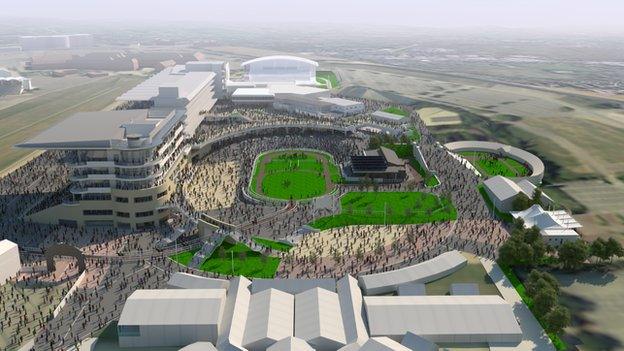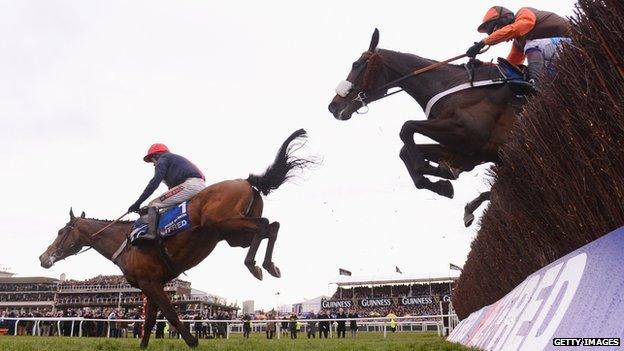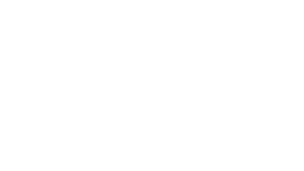Cheltenham Racecourse plans major £45m redevelopment
- Published

An artist's impression of the development - with the new multi-tiered grandstand on the left hand side
Plans for a £45m redevelopment of the flagship Cheltenham Racecourse have been revealed by the Jockey Club.
The proposed development would create a state-of-the-art new grandstand in place of the current "A&R" block, built in the 1920s.
In the past 30 years, The Jockey Club has invested £80m in facilities at Cheltenham.
Cheltenham hosts a four-day racing festival every year, the highlight of the National Hunt season.
The festival features the best jockeys and horses, and the 2013 Cheltenham Festival set new crowd records for its opening three days and sold out the fourth, Gold Cup Day.
Now, the Jockey Club has decided to undertake a major facelift, which will increase capacity and improve facilities. It will mean the demolition of the current royal box, which was built in 1952, and 55 other boxes built in the 1920s and 1930s.
'Jewel in crown'
As well as the major new grandstand - which will feature new members' facilities, public viewing areas, private boxes and royal box facilities - the plans also include improvements for owners and trainers.
There will be improved bar facilities, more toilets, and further viewing opportunities of the racing and the parade ring. A walkway for horses will be constructed, passing under a spectator walkway, and it is hoped the new designs will improve crowd circulation on the busiest days.

Cheltenham 2013 Gold Cup winner Bobs Worth lands on his way to victory in the race
"It is part of our job as the biggest commercial group in British horseracing to keep working on our facilities, and keep things up to date - we can never stand still," says Jockey Club chief executive Simon Bazalgette.
"Cheltenham is a jewel in the crown and is vital for racing as a whole in this country, and we need to make sure the facilities match that."
As part of the proposed redevelopment, which will need planning permission from the local borough council, there will also be more corporate facilities and boxes.
The Jockey Club runs 15 racecourses in the UK under its Jockey Club Racecourses banner, and as well as Cheltenham it also includes Aintree, Epsom Downs and the Rowley Mile and July Course in Newmarket.
Funding options
If Cheltenham planning permission is given and the necessary financing is in place, the main development will begin immediately after the 2014 festival with a scheduled completion date ahead of the 2016 festival.
During construction, Cheltenham would be able to continue staging its race programme as normal.
The Jockey Club will be responsible for funding and will not be seeking contributions from the local council, and neither will festival ticket prices be hiked as a means of paying for the project

Mr Bazalgette is looking for ways to boost interest in National Hunt racing in the early months of the year
"We have a range of funding options available to us, and that will be clarified over the next few months," says Mr Bazalgette.
During the construction period, Cheltenham will continue staging its race programme as normal, with temporary facilities - such as those used regularly at Royal Ascot - providing capacity in place of the A&R grandstand.
This will also allow the Jockey Club to generate similar revenues to normal from the venue to ensure there is no reduction in investment back into British racing.
Many of those who have boxes in the A&R block are families who have been using the facilities there for generation after generation over the decades.
"They are valued customers who have been with us a long time," says Mr Bazalgette.
"We will maintain communication with them... and are looking at creating a dedicated facility so they can enjoy the same social side of things, and networking, with the same group of people [from the A&R area]."
'Unique character'
On Wednesday the concept of the proposed Cheltenham development project was shown to council officers in advance of a detailed planning application being submitted in April 2013.
"There has been communication between us for quite some time in the run up to this announcement," says Mr Bazalgette.
"We will work closely with them. We think this enhances not only Cheltenham racecourse but the whole of the Cheltenham area."

It is envisaged the new design will help crowd flows around the race course
An exhibition about the project will be held in Cheltenham during April where local people can give feedback about the development.
"This development will enhance Cheltenham's unique character and is the last part of the grandstand development that began 30 years ago," says Robert Waley-Cohen, chairman of Cheltenham Racecourse.
"It focuses on two key objectives - maximising enjoyment of the horse and improving the overall Cheltenham experience for all race-goers."
Meanwhile, Mr Bazalgette is looking at ways to pep up interest in the National Hunt season in the period between Christmas and the Cheltenham Festival every March.
"Cheltenham is a great climax, which is then followed by the Grand National," he says. "I just don't think we make enough of the run-up, of the three or four months before that.
"I know there is the bad weather then, but I think there is work to be done there to spice things up and keep interest."